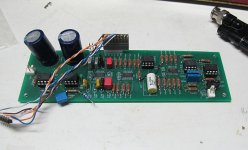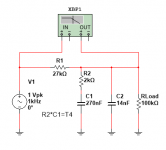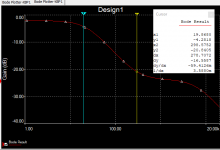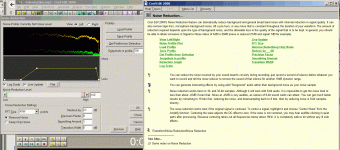I have a set of audio files rescued from a source of phonograph record like a gramophone. Very old family stuff records from my elders back in year 1946. A relative has digitalized these with a turntable and gave the records to me in lossless WAV Format. The audios are just conversations of my relatives in cotidiane situations. So it is just vocals materials but mixed with a heavy quantity of noise. Noise is mostly concentrated in the mid-high frequencies, like 1Khz-10Khz. So the records are VERY noisy. SNR is like 0dB or worst. My mission is to filter out the noise.
One advantage is that noise exhibits a cyclical pattern. I tried some classic vinyl restoration stuff like decracking o declicking with Sound Forge, DART 24 Pro. Results were unsuccessful. The best result I had is the "Noise reduction" effect in Audacity, which did output relatively good. But this last one just filters the frequencies where the noise is with narrow FFT. So the vocals content loses the high-mid frequencies. Leaving only mid or mid-bass content. The noise got down but voices are unintelligible.
So I think perhaps I could turn to a Artificial Intelligence solution?. but I have no clue from where can I start. I have some understading of theory of AI, the Perceptron, neural networks, Backpropagation, but I never applied them to audio. Perhaps a Convolution Neural network could be a solution, but how could I train it?. If helps, I have programming skills in C# and knowledge about digital linear filters like IIR and FIR. But equalization based solutions *are not, what I need *.
Below I offer an example track for your consideration.
Pista de CD 3.wav - Google Drive
What can I do for filter this kind of cyclical pattern noise?
One advantage is that noise exhibits a cyclical pattern. I tried some classic vinyl restoration stuff like decracking o declicking with Sound Forge, DART 24 Pro. Results were unsuccessful. The best result I had is the "Noise reduction" effect in Audacity, which did output relatively good. But this last one just filters the frequencies where the noise is with narrow FFT. So the vocals content loses the high-mid frequencies. Leaving only mid or mid-bass content. The noise got down but voices are unintelligible.
So I think perhaps I could turn to a Artificial Intelligence solution?. but I have no clue from where can I start. I have some understading of theory of AI, the Perceptron, neural networks, Backpropagation, but I never applied them to audio. Perhaps a Convolution Neural network could be a solution, but how could I train it?. If helps, I have programming skills in C# and knowledge about digital linear filters like IIR and FIR. But equalization based solutions *are not, what I need *.
Below I offer an example track for your consideration.
Pista de CD 3.wav - Google Drive
What can I do for filter this kind of cyclical pattern noise?
Probably need to try again with different stylus geometries and see if you can reduce tracing noise.
There is processing software that is good for recovering damaged analog recordings, but you will need a DAW like Reaper and the appropriate plugins and a lot of practice to get results that might be acceptable.
Best Free Noise Reduction Plugin to Use (Even if You're a Pro)
The Best VST Plugins for Noise Reduction | It Still Works
After all of this it may still be terrible. I've not devoted much energy to studying this and can't add more to the conversation.
There is processing software that is good for recovering damaged analog recordings, but you will need a DAW like Reaper and the appropriate plugins and a lot of practice to get results that might be acceptable.
Best Free Noise Reduction Plugin to Use (Even if You're a Pro)
The Best VST Plugins for Noise Reduction | It Still Works
After all of this it may still be terrible. I've not devoted much energy to studying this and can't add more to the conversation.
Try a 10 band equalizer, and experiment with cutting some of the treble bands. You may get lucky.
The original record was a mono 78. I've found that noisy mono records played on a stereo tt
(with the system in stereo mode) will place the noise on the sides, and the voice in the middle.
It is much, much more intelligible that way, even unfiltered. You'd need a stereo cartridge with
a special 78 stylus to try this. Shure had models like that. You would also need a 78 rpm capable
stereo tt. Of course, if you don't have the records, this won't help.
The original record was a mono 78. I've found that noisy mono records played on a stereo tt
(with the system in stereo mode) will place the noise on the sides, and the voice in the middle.
It is much, much more intelligible that way, even unfiltered. You'd need a stereo cartridge with
a special 78 stylus to try this. Shure had models like that. You would also need a 78 rpm capable
stereo tt. Of course, if you don't have the records, this won't help.
Last edited:
Funny, I was just looking for that today. I've used some of the free stuff and it's OK. But there was a paid version I had a trial of a few years back that was surprisingly good and specially for records. I wish I could remember what it was. If I find it, I'll let you know.
Hopefully the guy who did the transcription did it right. He would have had to use a 78 stylus, at least.
Treble cut on the old recordings can be -6, -8, -10 or -15dB at 10kHz!
I have the Shure M78 around here somewhere -- and an old, relatively inexpensive Thorens which I modified (all you need to do is add a potentiometer) to play the old recordings.
(Gary Galo wrote an article for Linear Audio describing an archival recording preamplifier. I modified it so that you could adjust settings on the fly with an MCU controller -- in this case Arduino) :
Attachments
(with the system in stereo mode) will place the noise on the sides, and the voice in the middle.
It is much, much more intelligible that way, even unfiltered. You'd need a stereo cartridge with.
hey, that's interesting!
Probably need to try again with different stylus geometries and see if you can reduce tracing noise.
There is processing software that is good for recovering damaged analog recordings, but you will need a DAW like Reaper and the appropriate plugins and a lot of practice to get results that might be acceptable.
Best Free Noise Reduction Plugin to Use (Even if You're a Pro)
The Best VST Plugins for Noise Reduction | It Still Works
After all of this it may still be terrible. I've not devoted much energy to studying this and can't add more to the conversation.
You did help a lot with your not devoted much energy. I'll try these along with the required patience. Thank you!
Sorry about I didn't mention this. The digital transfer were made like 10 years ago. My relative who made the transfer with his turntable died. So I don't have access to the turntable for playback, the discs/recordings, nor the cartridges. I have no idea of what cartridge or TT he used for the transfer. All I have are the WAV files.
Now in my country we are all in quarantine because of the COVID. I cannot get off my house for work. So in the spare time, they charged me with this task. That has some value to the history of my family. Thanks to you all for your help. Please keep giving ideas if you can
Now in my country we are all in quarantine because of the COVID. I cannot get off my house for work. So in the spare time, they charged me with this task. That has some value to the history of my family. Thanks to you all for your help. Please keep giving ideas if you can
I don't believe eq's based solutions could be the best, but at other hand you're right, a good treble cut from 8KHz should be obvious, because there is where the human vocal spectrum ends, and so the following frequency content only offers noise, so it should be filtered.Treble cut on the old recordings can be -6, -8, -10 or -15dB at 10kHz!
I have the Shure M78 around here somewhere -- and an old, relatively inexpensive Thorens which I modified (all you need to do is add a potentiometer) to play the old recordings.
(Gary Galo wrote an article for Linear Audio describing an archival recording preamplifier. I modified it so that you could adjust settings on the fly with an MCU controller -- in this case Arduino) :
I did as you said. I found in Audacity an effect called "Vocal isolation", that allows to "Isolate vocals", and "Isolate center". The two effects made almost the same output, but I'd prefer "Isolate center". Then a put a 4th order lowpass filter at 8KHz, to clean up the high frequency noise. A bit of gain up, a bit of compressor. And that's the most I can do. So thanks again for your help.Try a 10 band equalizer, and experiment with cutting some of the treble bands. You may get lucky.
The original record was a mono 78. I've found that noisy mono records played on a stereo tt
(with the system in stereo mode) will place the noise on the sides, and the voice in the middle.
It is much, much more intelligible that way, even unfiltered. You'd need a stereo cartridge with
a special 78 stylus to try this. Shure had models like that. You would also need a 78 rpm capable
stereo tt. Of course, if you don't have the records, this won't help.
I tried an awesome filter based on AI called RNNOISE. Quite incredible, filtering background noise with SNR of 5dB. But in my problem the SNR is quite worst. Vocals are at the background, and noise in the foreground. I realized that I'm asking for magic.
I didn't like the FFT based filters because they add awful artifacts that make the speech unintelligible, and harder to understand.
I have no idea how they do to "isolate center" mathematically speaking, suppose you got
L = A + B , and
R = B + C
L+R = A +2B + C
L-R = A - C
how to got B?, it's like trying to solve a linear three variable system with two equations...
So far so good. Thanks to you guys all.
DeNoise & DeNoiseLF – dehiss and denoise your audio | Audio Restoration | Brian Davies might be worth a check. There is a trial before buy so you can at least check it. The declick sw works very well. Written by a retired mathematician for restoring old 78s!
In terms of isolating the centre the usual way is to convert to sum and difference channels (L+R and L-R), filter the diff channel then recombine, but as you had a mono source summing to mono should remove the vertical noise.
In terms of isolating the centre the usual way is to convert to sum and difference channels (L+R and L-R), filter the diff channel then recombine, but as you had a mono source summing to mono should remove the vertical noise.
so far, altough it made me install JRE 1.5, this tool gave very good results!DeNoise & DeNoiseLF – dehiss and denoise your audio | Audio Restoration | Brian Davies might be worth a check. There is a trial before buy so you can at least check it. The declick sw works very well. Written by a retired mathematician for restoring old 78s!
In terms of isolating the centre the usual way is to convert to sum and difference channels (L+R and L-R), filter the diff channel then recombine, but as you had a mono source summing to mono should remove the vertical noise.
> in cotidiane situations
"Everyday".
The Noise Filter in CoolEdit 2000 could do some amazing work.
First you show it a sample of "quiet" (full of noise) and let it study it.
Then you run a lot of trials against the speech. There are many settings for frequency and aggressiveness.
A friend had pre-WWII 78s with great childhood nostalgia; but also massive childhood scratches and dirt. I got them listenable. (Russian Army Choir on Columbia, great recordings; and I did hunt for cleaner copies before doing all that work.)
My family had a cam-corder of a family reunion, badly tainted with wind noise (also too-far, too-soft, too-hissy, etc). It got it better.
Problem: the company quit the business, has not been supported in many years. It always was a little tough to get registered. I *just* got it 99% working on Win7; but I am not inclined to accept massive WAVs and listen to people I don't know (and won't understand?).
"Everyday".
The Noise Filter in CoolEdit 2000 could do some amazing work.
First you show it a sample of "quiet" (full of noise) and let it study it.
Then you run a lot of trials against the speech. There are many settings for frequency and aggressiveness.
A friend had pre-WWII 78s with great childhood nostalgia; but also massive childhood scratches and dirt. I got them listenable. (Russian Army Choir on Columbia, great recordings; and I did hunt for cleaner copies before doing all that work.)
My family had a cam-corder of a family reunion, badly tainted with wind noise (also too-far, too-soft, too-hissy, etc). It got it better.
Problem: the company quit the business, has not been supported in many years. It always was a little tough to get registered. I *just* got it 99% working on Win7; but I am not inclined to accept massive WAVs and listen to people I don't know (and won't understand?).
Attachments
Already tried Waves XNoise today, very good. It does remove the noise, but affects very much the speech quality turning it unintelligible. There is many quite good software. Waves products are awesome. But for my specific problem the best result by far is given by DeNoise as told by billshurv.the waves xnoise plugin can do a good job if the noise is constant, you let it sample a second of the noise and thats what it removes from the audio, more or less. there might befree ones that do the same thing.
My real problem here is all of these software. DeNoise, Waves XNoise, Audacity plugins, they are all really good pieces of soft. Those erase the background noise. But my specific case is not background noise, it is foreground noise, and wanted signal is covered by noise. masked sound is lost sound. It's like discerning the speech of a person in the middle of a crowd from a far point
It's seem I have a negative SNR. The original recording was done very badly, because people were far from the microphone recorder of the gramophone. so there is a weak speech signal, room acoustics, and add to it the heavy noise.
At this point I stopped hoping for restoring this material.
- Status
- This old topic is closed. If you want to reopen this topic, contact a moderator using the "Report Post" button.
- Home
- General Interest
- Everything Else
- How can I filter heavy gramophone noise?



